Text
The Last of Us Part 2: Electric Boogaloo
Thanks for visiting Seattle! Fuck you and get out: The Game
I originally started this review almost immediately after the game’s release in June 2020; I have, of course, sat on my ass and done fuck all with it in the time that’s since passed. After recently going back through for another replay I’ve added a bunch of thoughts alongside my initial thoughts & feelings below. Please enjoy- only taken me three actual fucking years to finish the thing. At one point, about midway through The Last of Us 2′s gruelling 20+ hour campaign, Ellie lets out an exasperated “Fuck Seattle”. Yes Ellie, fuck Seattle. Fuck Seattle indeed.
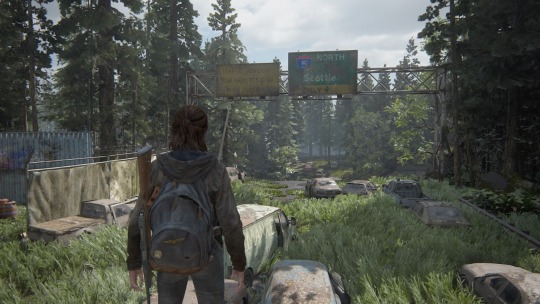
I’d turn around tbh m8.
If the past year in the real world (It’s really fun isn’t it) have taught us anything, it’s that human beings can be harsh, unkind and animalistic in their instinct to look out for number one in the face of an uncertain threat. The Last of Us Part 2 isn’t interested in archetypical videogame escapism, generic heroic character tropes or trite ‘and everything was fine in the end’ storytelling templates. It’s harrowing and nihilistic, it worms its way into your thoughts and lingers long after you’ve put the controller down, and it seems to take great joy in breaking its characters and making them resign to the inevitable violence of this crushing and sadistic world; but with the world thrust into post-apocalyptic oblivion, what good would sugar-coating things do?
The Last of Us Part Dos is not a pretty game per se. It is, and remains from a technical and graphical standpoint, one of the finest looking games we’ve seen to date, but thematically it’s a dilapidated wreck, a car crash sprawled across the side of the road that you slow down to gaze at through pure morbid curiosity. It’s brutal, harsh, and harbours a borderline terrifyingly grim obsession with violence and the consequences that that violence wreaks, and the ostensibly blasé attitude that the game’s world and its inhabitants have towards its sadistic violence, routine killings and acts of pure horror only serve to highlight this. Its encroaching, hopeless attitude and world design will consume you in a similar way to games like Dark Souls & Bloodborne, baiting you into pushing through the seemingly endless cycles of violence and exploration of a shattered, post-pandemic USA; its pacing and story laden with twists and turns will sink its hooks into you from the very start and refuse to let go; the paths the two lead characters tread constantly looping and weaving their way back on each other in an almost Pulp Fiction-esque scenario reel. This is a game that strings you along a trail of impossible decisions and terrifying situations and forces you to keep pushing forward, no matter what the cost, because you just need to get to that point on the horizon and maybe, just maybe, find some reason to continue on. There’s that morbid curiosity again.
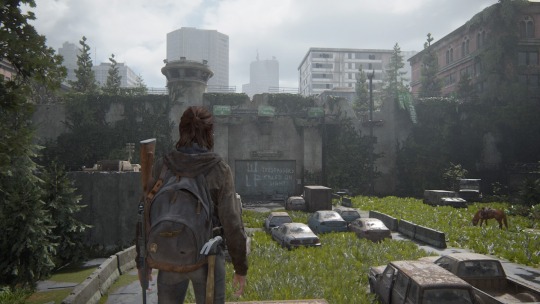
Abandon hope all ye who enter here.
When looking at the Last of Us Part 2: Die Harder we need to look beyond the generic post-apocalyptic zombie (let’s use that term very fucking loosely, shall we?) third person shooter Walking Dead simulator that - much to their chagrin - a large portion of players are content to class this and the first game as. To simply call this game gritty would be a disservice; ‘gritty’ conjures up images of every third person shooter & FPS game of the last decade, where everything is grey, the game world is strategically and deliberately lined with chest-height piles of rubble and burnt-out cars, and a gruff, shaven-headed, generic angry white guy protagonist is left to breathlessly “HNNNGHHHH” his way around the environment whilst shooting Russians/aliens/street gangs/brown people in the face whilst the game’s script writer may as well be audibly fucking screaming in the background of said awful main character’s inner monologue about justice, revenge, or redemption- all the generic ‘i’m going to shoot up a school one day’ tropes that gamers™ so dearly love. (Read: Gears of War, Killzone, Kane & Lynch, Homefront, every Call of Duty game ever - man the 2010′s were fun, right?)
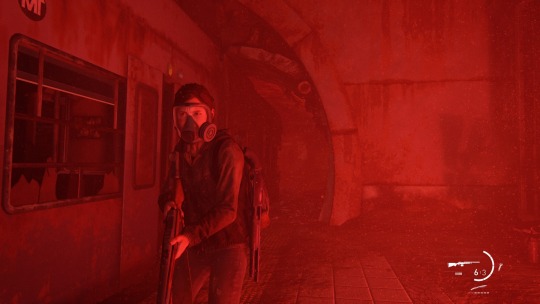
Turns out Roxanne really, REALLY wanted to put on the red light.
The Last of Us Episode 2: Attack of the Clones transcends the traditional post-apocalyptic ‘gritty’ videogame. It leaves behind the failed promises of the ‘destroyed beauty’ of a ruined world made by games like Gears of War, Fallout, and every other videogame ever made post-2005; Instead it gives us an inherently bleak glimpse into an increasingly savage and all-consuming world that’s struggling to claw its way back to some semblance of civilisation amid sparring human factions and the threat of the infected, where ritual killings and escalating violence are a day-to-day occurrence. So no, it’s not pretty, but then the apocalypse wouldn’t be pretty, would it?
From the outset, The Last of Us: The 2 Towers is a stark exercise in the age-old life lesson of what you want not necessarily being what you need. The Last of Us Part 1 ended with an iconic, Sopranos-esque fade to black cliffhanger. It left us with a million unanswered questions, sure, but the fates of Joel and Ellie were effectively left frozen in time and our imaginations were left to try and work out what happened after. They were safe, as safe as ‘safe’ can be in their world, in videogame canon as they existed solely within that first game. Since the initial rumours were being thrown around that developer Naughty Dog was working on a sequel to the 2013 game, people were split down the middle as to wether or not this was necessarily needed, at least for Joel and Ellie’s story-arc. But fans clamoured for it, Sony surely knew that a sequel would make racks on racks on racks, and thus, I’m Going To Silently Choke Every Enemy I Come Across For An Uncomfortable Amount Of Time Whilst Gurning 2: The Game was born; Which is essentially Naughty Dog saying “Here’s that sequel you wanted, but you best believe it’s gonna cost you. We’ll be taking £50, and all that emotional baggage you’ve been carrying for 7 years”. From the off the game makes itself clear that it is not interested in being a run-of-the-mill, merry little zombie-killing jaunt; it won’t be a thrill-ride like Naughty Dog’s own Indiana Jones-simulator Uncharted 4 that peddles a paper-thin ‘mature’ ‘uh-oh! looks like the past has finally caught up with this hero!’ narrative that digs itself a hole and then seemingly resolves itself out of nowhere at the last minute. The Last of Us Part 2: Judgement Day is an uphill slog through increasingly brutal choices and actions because, and never forget, you said that you wanted this - it’s an exercise in teaching you, no matter how much you don’t want to learn this particular lesson, that your actions have consequences; Everything you did to survive in the first game comes home to roost and you’re going to have to live with that. We should’ve listened to that wrinkly little sex grandad Mick Jagger when he told us we can’t always get what we want.
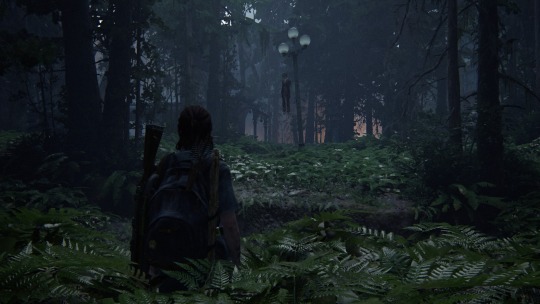
‘‘If you go down to the woods today... don’t”
Rockstar’s 2010 confused-cowboy-scowls-at-things epic Red Dead Redemption could have ended with a similar fade to black as The Last of Us at the moment that protagonist/anti-hero/annoyed horse rider John Marston calmly accepted his fate and finally opened up those barn doors during his daring last-stand against government agents; we of course knew he was doomed, but in our heads, and in videogame canon, he would have remained alive because we didn’t see any triggers being pulled, and that’s the way it would have stayed. Ultimately that doesn’t happen, and you’re forced to watch as John is ‘atoned for his past sins’ as it were in the form of being violently gunned down for his years of robbery, violence and general rootin’ tootin’-ness running with his old gang of hat wearers and ‘WHAT IN TARNATION’ shouters. The Last of Us Part 2: The Lost World hammers home a similar principle; its violence is almost biblical in its nature at times, thematically an ‘eye for an eye’ as its characters and its world no longer know how to respond to acts of violence with anything other than more violence. All the while, you’re forced to find a front row seat, make yourself comfortable, and enjoy the show- because try as you might, you just can’t look away, can you?
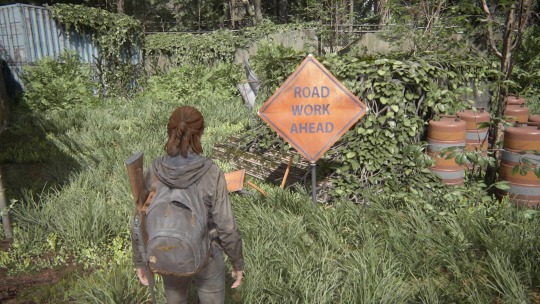
“Road work ahead? Uh, yeah, I sure hope it does.”
The Last of Us Part Deux opens with a slightly greyer, slightly gruffer, still #dadgoals Joel confiding in his brother Tommy as to how and why he did what he did in that hospital in Utah a few years ago. It’s apparent from the offset that there is an air of considerable tension between Joel and Ellie, with the overarching theme of the few Joel and Ellie flashback sequences mostly being used to show Joel desperately try to claw his way back to the dynamic that the pair had towards the tail end of the first game. The relationship between Joel and Ellie is again at the core of this game’s storytelling, but as opposed to building this relationship up via a slow-burn to an explosive crescendo like in the first game, this time we’re shown all the times it was dismantled and patched back together again over the gap between games. We see Joel’s ham-fisted and bungling attempts at some sort of traditional father/daughter bonding with Ellie, his desperation to get back to some semblance of a natural dynamic between the two as he visually struggles to come to terms with the fact that she might not need him anymore; that she’s growing up and wants to forge her own path in life, even if that means holding him at arm’s-length and keeping her distance as she learns her own life lessons and makes bad decisions, all whilst he tries to win her affection once again like an absent father, with guitar lessons and terrible dad jokes. With the dents in their relationship laid bare for all to see, it’s the frustration, guilt and weight of all her own, and those that she loves, past decisions that Ellie harnesses into her driving force during this game. This is a tale not of survival, of hope or of fighting against the odds as it was in the first game; this is a tale of violence and the cycle of revenge that it brings, of all-consuming inner turmoil, and of the repercussions of every single decision that you make in this unforgiving world.
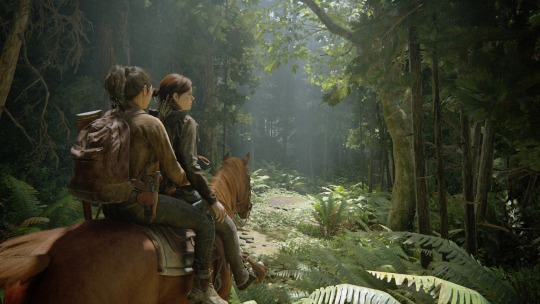
“YEAAAAAH I’M GONNA TAKE MY HORSE TO downtown Seattle”
The moment that sets up the pieces in play for the remainder of the story is the brutal execution of Joel at the hands of an initially unknown hostile faction, with another angry young woman also seemingly carrying a lot of emotional baggage striking the killing blow to an almost unrecognisable bloody and beaten Joel. (Think that bit from the first BioShock. If Tarantino directed it. It’s even got a golf club too) It happens, it’s over in a flash, and we’re left to sit there reeling and cursing, thinking ‘surely not?’; we’re almost indoctrinated through movies/TV/videogames to be so used to seeing a beloved character be saved in the face of impending death right at the last minute by someone crashing in from out of nowhere, gunning everyone down and saving the day. This never arrives. The Last of Us Part 2: The Chamber of Secrets delivers its mission statement forcibly here and lets you know that you’re not going to like where this story is going, but by god does it know that you’ll want to see it through to the very end. We see all of this through the eyes of Ellie; This, the death of her father-figure, her best friend, her confidant and the only real protector she’s ever known executed like an animal in front of her as she lies bloodied and helplessly pleading with the attackers, unable to do anything other than watch. Sound fades from the scene, you hear Ellie’s rapidly increasing heart rate, her franticly gasping for breath as she lies staring dazed and so desperately confused into the eyes of the corpse in front of her that she once knew as the only real constant in her life. It’s this moment that Ellie is forced to relive over and over again throughout the course of the game as we slowly but surely strip away all the generic videogame pre-tense and even all the usual ‘Look, she’s a girl kicking ass in a videogame! She’s got a bow and arrow too, like Lara Croft! Good for you! Feminism!’ theme that even the game’s own trailers and promotional material would lead you to believe; and yes, Ellie is still presented to be the same incredibly brave, headstrong, determined and quick-witted character we grew to love from the first game, but she’s also shown to be a scared, confused and alone 19 year old struggling with PTSD.
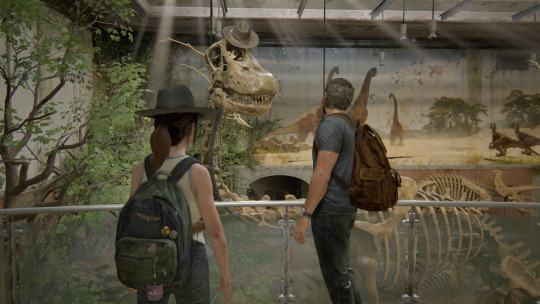
“Life, uh, finds a way.”
The Hideo Kojima-esque bait-and-switch ruse that The Last of Us Part 2: 2 Fast 2 Furious pulled in all its pre-release trailers and marketing created various rabid fan-theories and story speculation in the months leading up to the game’s release. The inclusion of Joel in these trailers alongside a pissed-off, scowl-y and vengeful Ellie pointed to the roles being reversed and daddy Joel now essentially being the Yoda to Ellie’s incredibly more bloodthirsty Luke Skywalker (More so to pop up every now and again and go “R U SURE??” whenever Ellie mentioned that she felt like murdering lots of people in the name of revenge, less singing about seagulls), only to have him replaced by another character in the final version of the game on account of Joel having a fucking golf club wedged into his skull. This was reminiscent of the aforementioned videogame genius/absolute #madlad Hideo Kojima and the now iconic deception/shithousery that he pulled prior to the 2001 release of the massively (understatement of the century?) anticipated Metal Gear Solid 2: Sons of Liberty. Swapping out fan-favourite and previously sole mainline series protagonist Solid Snake for the rookie Raiden was a hell of a gamble, especially considering you play 90% of the game as the angst-ridden, confused, ‘LOL HE LOOKS LIKE A WOMAN RIGHT GUYS???’ newcomer, while Snake just swans around in the background looking effortlessly more badass and heroic whilst smoking more than Dot Cotton during a particularly stressful episode of Eastenders, all the while being weirdly aroused by guns at every opportunity he’s given to talk about them. (Which was something they kept for the sequel because, Kojima. Like father, like genetically-engineered clone son, I guess?)
Many videogames since, and indeed before Metal Gear Solid 2, have pulled the trick of replacing characters in trailers/promotional material in a bid to pull the wool over the eyes of the player and give us that ‘WHAAAAA??’ moment that we all so dearly crave (Go contract amnesia, play Bioshock again and tell me that twist doesn’t hit you like a truck. Depressingly, in the 13 years since it’s never been bettered. Fight me); Halo 2 did it by making you play as the bad-guy-that-isn’t-really-bad-because-the-evil-space-monkeys-were-actually-the-real-evil-ones-all-along Arbiter for half of the game (then made him unplayable (Co-op doesn’t count, shut up) in Halo 3 when he has THE BEST MOMENT IN THE WHOLE FUCKING GAME); Assassin’s Creed 3 planted you in the shoes of the generic Pirates of the Caribbean bad-guy-reject Haytham for what felt like an eternity before the AND YOU WERE EVIL THE WHOLE TIME reveal, and in Metal Gear Solid V: The Phantom Pain Kojima returned to the well one last time, casting you as Big Boss, but not really, but really for a little bit, but then actually not really again, but then it turns out the whole time he was sort of watching you? Like some sort of private militia warlord voyeur? Because videogame plots? (That’s an essay for another day)
The internet-breaking-before-the-internet-REALLY-took-off MGS2 rug-pull that Kojima pulled some 22 years ago set the precedent for a way of framing a lead character as something more than a one-dimensional ‘hero’; Raiden’s reverence for Solid Snake in MGS2 is that of the player themselves- this is a character that you journeyed alongside and fought countless battles with standing across from you, now in the shoes of the inexperienced rookie. You’re clamouring to get back into the safe and familiar role of Snake because the game frames him as this unflappable badass - the quintessential action hero; In the Last of Us Part 2: I Still Know What You Did Last Summer there remains a discourse regarding the fact that you do not play as the experienced & battle-hardened Joel and instead take on the roles of two women in Ellie & Abby who, whilst this cold-blooded world is the only one they’ve ever known, are still the ‘rookies’ in this story - this journey of revenge, violence and ultimately the guilt and trauma that your actions wreak over the course of the narrative is amplified all the more due to the fact that it’s these character’s ‘first time round’ so to speak - these are the mistakes, consequences and life-lessons that they must endure in this fractured world where there are no second chances.
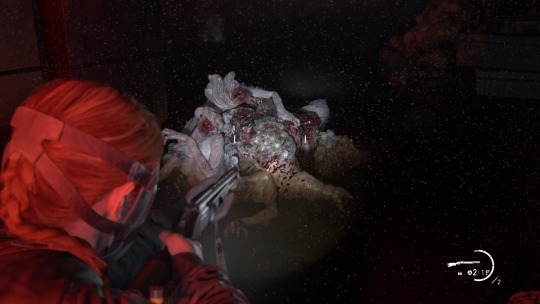
“And who could forget dear Rat King?”
The implosion heard across the internet that coincided with the release of The Last of Us 2: The Wrath of Khan was solely united in one voice: ‘GIRL WITH MUSCLES BAD’. The outpour of vitriol that spawned from the surprise character switch midway through the game’s campaign to place you in control of Abby (Aforementioned golf-club-to-the-head-of-Joel lady) for another 10 hours or so was met with relentless criticism from fans; ‘BUT THE MEAN LADY KILLED THE NICE DAD MAN!’ shouted middle-aged men in their droves. ‘SHE HAS MUSCLES AND SCARES ME AND I DON’T WANT TO FUCK HER. THIS GAME ISN’T WHAT I WANTED’ screamed more generic videogame-men into the void that is the internet post-2020. Complaints of ‘WHERE HER BOOBS @????’ echoed off of parent’s basement walls everywhere. The guttural screams of ‘WOMAN WITH MUSCLES LOL LESBIAN!!! UNREALISTIC BODY!!!!’ were heard pouring forth from every male human currently in existence with one of those shit incel goatee-neckbeard things.
The inclusion of Abby’s playable role in the latter half of the campaign is something of an emotional sucker-punch, but ultimately upon reflection it becomes the rarest of all beasts: a story arc that genuinely makes you reflect on your time spent with Ellie & Joel, and leads you to question if they were ever the ‘good’ characters all along. In a world such as The Last of Us’s post-apocalyptic, pandemic-ridden and feral United States, do such black and white tropes as ‘good’ and ‘evil’ really even exist anymore?
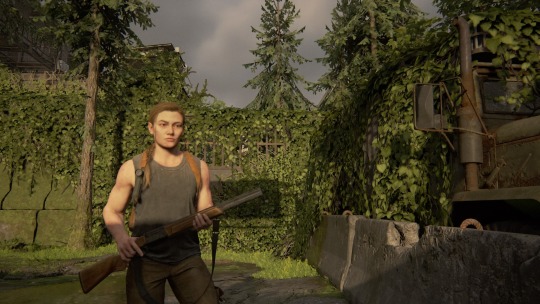
Took a wrong turn on the way to the Sarah Connor convention.
Abby’s story runs parallel to Ellie’s on the surface; a tale of revenge wrought by two emotionally-scarred young women, fuelled by a hatred that has been simmering within for years ultimately coming to an explosive climax. Unlike Ellie, who’s angst and resentment in the years since the first game has almost been lost in the mire of what you sense is a near-constant feeling of emptiness and boredom, left to settle into a ‘normal’ life in a cosy community and longing for some sort of action to happen; Abby’s years have been a juxtaposition to Ellie’s, with a clear goal in mind throughout: find the man responsible for the murder of her surgeon father in a hospital in Utah all those years ago, and make him and his loved ones suffer as she has suffered. An eye for an eye. While Ellie meanders her way through awkward community encounters and plays the role of wayward teenager to Joel’s doting and over-protective father-figure, Abby splinters off from the Fireflies to join Seattle’s paramilitary u-like-cargo-pants-and-guns?-we-got-‘em group The Washington Liberation Front, hones her favourite craft of killing people the fuck dead and sets off on a road trip to Jackson to wedge some steel into an old man’s skull. Despite Abby being painted as this almost mythical bounty during Ellie’s campaign, the elusive wrecker of your world and your very own white whale, dodging you at every turn and always being just over the horizon, in reality she is also a scared, vulnerable and ultimately alone young woman forced to put on the facade of a cold-hearted mercenary to simply survive in this turbulent and merciless world. The joining of the WLF after the failure of the Fireflies, the on/off/on again relationship with Owen, the pilgrimage to Jackson to exact an almost sacrificial killing; all ultimately just treading water in an attempt to fill the void in the wake of the death of her own (actual) father-figure. Through Abby’s eyes we experience the redemptive arc of an archetypical ‘going native’ story, powered by the simple notion of having to do something ‘good’ to experience some feeling of atonement, for the weight to be lifted, if only for a fleeting moment, of all the past atrocities you have committed. An eye for an eye.
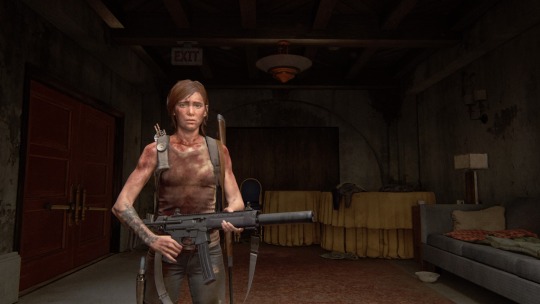
“No, MY Sarah Connor cosplay is better!”
In retrospect I found myself more drawn to Abby’s character after playing through her story arc- the WLF fallout, the Seraphites and their Dark Knight Joker ‘You wanna know how I got these scars?’ faces, Lev & Yara, the tower crane bridges, the island assault, ground zero & the Rat King, Santa Barbara, the Theatre showdown - the character flip and interrelated narrative threads constantly worming their way back to have the two lead characters miss each other by a fragment at key locations keeps the tension and the stakes high amid an ever-shifting stage. Seeing the story unfold from the time it takes to complete Abby’s story arc made me almost forget Ellie’s arc as the pure intensity and turbulence of Abby’s plot points succeeded in making me harbour some degree of resentment towards Ellie once control was shifted back to her; I switched 360 degrees to seeing the impact of the decision made by Joel in the first game and the destruction and violence that Ellie had wrought on what you initially believe to be a valid revenge quest- ultimately The Last of Us Part 2: The Desolation of Smaug paints its world and its characters if not in blood red, then entirely grey. There is no room for black & white, good & bad, hero & villain pretence in a world where the light has all but faded.
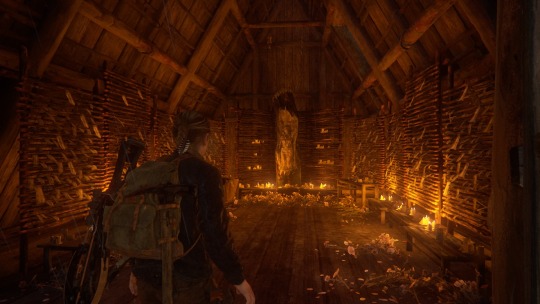
Y’all like creepy cults? Boi do this game got ‘em!
The Last of Us 2: The Temple of Doom is a masterclass in subverting expectations and keeping you on tenterhooks throughout. It’s a cornucopia of brilliant Tarantino-esque standoffs and intertwining story beats, edge-of-the-seat moments and its constantly shifting, always incredibly trepidatious playing fields mean that you are never truly in control. It’s harrowing, it doesn’t ever give you a moment to catch your breath and it revels in pulling the floor out from underneath you at multiple points throughout the story it tells, it’s unforgiving, desolate and simply unforgettable. It’s one of the most important games I’ve ever played and always creeps back into my thoughts yearly for another play-through.
0 notes
Text
Burnout Paradise: Remastered, Revisited
10 long years away from Paradise City, oh won’t you please take me home?
Within 10 minutes of starting Burnout Paradise Remastered, I’d received my first car, won my first race, taken out 6 rival racers along the way, hit 3 super-jumps (whilst barrel rolling), and then smashed head-first into an unexpected wall, nitrous blazing. All whilst Killswitch Engage’s My Curse is being blasted at me; It’s an understatement to say that I fucking love this game.
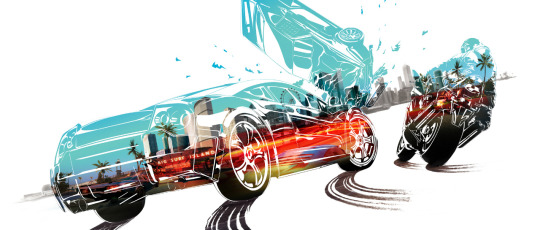
Potentially, (Or at least every fibre of my being really fucking hopes so) Burnout Paradise has been given the remastered treatment to gauge if Criterion’s brand of smashy smashy racey racey boost lots go fast vroom cars game is still as popular as it once was in the halcyon days of the mid 2000′s. After Burnout 3 wiped the floor with every other racing game released in 2004 and instantly gave the arcade racing genre the shot in the arm that it so desperately needed, Criterion went away and thought ‘How do we improve on perfection?’, upon which, I like to imagine, Axl Rose appeared to them in an ethereal haze and screeched ‘TAKEEEEE. MEEEEEE. HOOOOOMEEEEEEEEEE’ like a mad little goblin whilst drawing them a map of an open-world play-box full of destruction. Thus, Burnout Paradise was born, answering the age-old question that was ‘How do you make Burnout 3 better?’; Easy, by making it bigger, and turning everything up to 11.
For it’s age, Paradise looks gorgeous when given it’s new lick of paint; Cars positively glow in the daytime sun and shimmer under the lights of the nightime city, and the sunny haze of Paradise City looks as good as the day it debuted. Screaming through the roads, dodging in and out of alleyway shortcuts, hitting jumps and smashing through obstacles all ran at a silky-smooth framerate and felt downright ridiculous all over again. Paradise Remastered comes with the base game’s DLC add-on area Big Surf Island, all previous DLC cars (and motorbikes), as well as all online multiplayer modes. Having previously never played with any of the DLC cars or areas, careening along at 2958695MPH in a fucking DeLorean in hover mode (?!?!) whilst listening to Girlfriend by Avril Lavigne is, well, a bit fun.
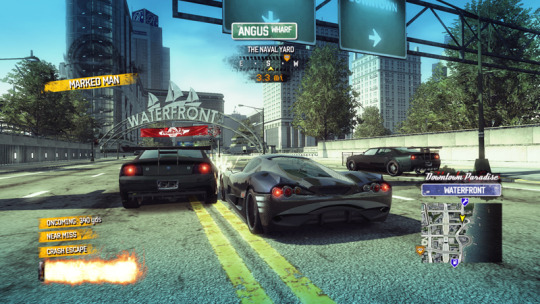
Paradise City, as a sandbox, contains a veritable wealth of collectibles to smash, hurl your car into/off of, shortcuts to find and cars to obtain. The routes on which you take part in races, elimination events and time trials are not mapped out for you; The game lets you choose how to get to your destination, whichever way you please. Be it sticking to shortcuts and jumps to put distance between yourself and your rivals, or building a boost chain by smashing collectibles, drifting and driving recklessly, or simply by reducing everyone else taking part in the event into a burning wreck at the side of the road by way of the game’s signature takedowns. Your call. Paradise’s roads are simple to learn, yet tricky to master. An hour into the game, muscle memory kicked in and I was quickly falling back into old favourite routes on Stunt Run events, re-learning the best shortcuts and throwing my car off of some of the biggest and best super-jumps in Paradise City. Today’s youth will never experience the sheer thrill of being a 13 year old, endlessly switching channels between the Xbox and the TV on a Friday night, trying to catch the best bits of The Friday Night Project and IT Crowd, then switching back to the Xbox during the ad breaks and hurling your car off of a cliff, spinning 360 degrees and then smashing it into the side of a building, and driving away like nothing happened, squealing like a madman.
Progression in Burnout Paradise is simple: win events (Be it races, takedown challenges or time trials) and earn points on your driving licence. Hit a set amount of points and you upgrade to the next class, going up through the ranks until you eventually hit the Burnout Elite licence. At the start, it’ll only take you 5 or so wins to bag your first licence, and each time you progress, the amount of wins you need increases. After upgrading your licence, the world map resets and all previously completed events are now re-playable, with added difficulty. There is a bewildering level of freedom in Paradise as to how you go about progressing; You are not locked into a set course of races or events in order to progress, how you go about it is entirely up to you. Fancy replaying the same stunt run routes over and over again in order to master them and rack up a ridiculous combo chain? Knock yourself out. It’s a progression system that is, pun intended, not designed to burn you out; If you have a favourite type of event then you’re welcome to stick to that, Paradise doesn’t shoehorn you down a set path of events and pre-determined progression, it holds your hand for five minutes and then pushes you, head-first, off of a cliff.
Burnout Paradise is a game that you play to switch off, to tune out all distractions, and, for however long it may be, smash some shit up and have some pure, unadulterated fun. It falls into the same bracket as games like the Tony Hawk’s series; It’s so easy find yourself returning to re-run the same routes over and over again, hitting the same jumps and listening to the same tracks, because it’s never a chore, it’s so much unbridled joy that it never feels like you’re going through the motions. For one brief moment in time, you’re 13 again, in the bedroom of your mum and dad’s house, having the best fucking time of your life.
Also it has Stand And Deliver by Adam & The Ants on the soundtrack. 11/10 game of the year every year.
-DU
0 notes
Text
We Are Scientists- Helter Seltzer Album/Live Review
Indie-rock cult heroes turned power-pop stalwarts We Are Scientists return to the scene with their fifth studio album, ‘Helter Seltzer’; Have the scientists perfected their formulae this time around?

We Are Scientists achieved cult status in the mid-2000′s with their debut LP With Love And Squalor; A standout album amid the indie boom of the time, tracks like ‘Nobody Move, Nobody Get Hurt’, ‘The Great Escape’, ‘It’s A Hit’ and ‘This Scene Is Dead’ combined razor-sharp guitar riffs with thunderous drums and stadium-sized singalong choruses to create instant Indie-disco classics. Over the years that followed, duo Keith Murray (Lead vocals, guitar) and Chris Cain (Bass, backing vocals) have mellowed their sound slightly since their electric debut effort, turning their hand to perfecting their power-pop sound with each album; 2008′s Brain Thrust Mastery, 2010′s Barbara and 2014′s Tv En Français proving each time that the pair have a unmatched knack for writing instantly catchy hooks and singalong choruses, and Helter Seltzer sees them at their most polished, thunderous and charming best.
Helter Seltzer kicks proceedings off with the rambunctious lead single ‘Buckle’, which sees a relentless drum track and bassline that constantly thump along in the background, a signature stadium-sized riff that kicks in around the chorus, coupled with an added synth line and vocal harmony that lifts the track to a grander stature; Murray’s wailing vocals on the chorus, his pleading, albeit almost cocky lyrics ‘I wish I could bottle everything you need/I want you to buckle when you think of me’ and a chorus of background ‘Ooooh’s’, alongside a hefty guitar solo, adds to the power-pop feel of the track. ‘In My Head’ sees a softer, dreamy guitar line flow into a more powerful chorus, making it inevitably hit harder. Add in the occasional 80′s-style synth stab, and you have a glossy, soft-rock track with a glittering synth-feel.
‘Too Late’ is arguably one of the standout tracks on this LP; A crooning vocal delivery from Murray, a hugely prominent, fuzzy bassline and one-two snare hits on repeat make for the most dreamy, pop-infused track on the album. A chorus that pretty much screams to be sung along to sees a glimmering synth run over Murray’s begging ‘Don’t just turn and walk away/Don’t stop now, it’s never too late’, with added piano-stabs punctuating the honest, instantly catchy chorus that this track is packing; This album’s ‘After Hours’, if you will? ‘Hold On’ includes a thunderous bassline that drives the track, with a messy, tremolo-laden guitar floating over the top, as harmonious vocals overlay and lift the track from it’s otherwise middling feel. The added sheen of the piano and glimmering synth that this track has leads to a real pop-esque synth-led breakdown in the middle eight; keyboardist Max Hart putting his time spent playing in Katy Perry’s band to good use, with the breakdown seeing fluctuating, almost club-like synth wailing in and out over Murray’s vocals.

‘We Need A Word’ is the most basic track on the album, though the chorus does its part to lift it somewhat, with powerful drums thumping away alongside a meaty bassline on the chorus, breaking up the slower verses that lack a little punch. It’s follow-up is however, one of the standout tracks on the album. ‘Want For Nothing’ seems like the perfect album closer; Murray’s soft vocals coupled with easily the most heartfelt and honest lyrics on the album ‘I can’t do this alone/So take me home, you’ll want for nothing’, alongside a stripped-back arrangement of acoustic guitar, strings that crescent into a bassline that drives the chorus and piano added in alongside the strings to elevate the track to a surprisingly powerful and emotional level. ‘Classic Love’ follows, and seems like an immediate response to the track it precedes; A signature, venomous guitar-riff faces off against pounding drums, heading towards an acoustically-charged breakdown, before diving back in to it’s familiar, relentless rock & roll.
As the album comes to a close, ‘Waiting For You’ sees an acoustic guitar overlayed with a more powerful, distorted guitar line, which stops the track from feeling somewhat by the numbers. Once again, harmonious vocals from the duo give the track a grander feel, although the overall structure is a bit too stop-start, stop-start to really work up a head of steam. The track does end strongly however, and the middle-eight is easily the highlight, with a thunderous, heavily distorted guitar kicking in alongside Murray’s punchier vocals. ‘Headlights’ is a throwback to more classic indie-rock; A track that sounds like a B-Side from the With Love And Squalor days, rough, pacy guitar and bass lines run alongside more pumped-up vocals, the stuttering nature of the track surprisingly working more than it did on the previous track, thanks to the consistent pace and strong chorus. Album closer ‘Forgiveness’ is an all-out, powerful pop-rock track, the almost hair-metal guitar solo that erupts in the middle of the song is reminiscent of a Bon-Jovi stadium-rock ballad. It hits hard, fast, and with a layer of polish; A perfect way to close the album.

Following on from the launch of Helter Seltzer in late April, We Are Scientists hit the road on tour, and I was lucky enough to bag myself a ticket to their show at the Bierkeller in Bristol. My third time seeing the duo (Backed on drums by the incredible talents of Keith Carne), having previously seen them in 2010 and 2013, I was unsure if they’d top their previous sets, but they delivered, and they did it in unmatchable style. Taking to the stage suited in all black, the band tore into ‘This Scene Is Dead’, to a huge crowd reception. Murray throwing himself around the stage as he attacked his guitar throughout the night, belting out choruses and nailing note-perfect guitar solos amidst the relentless energy of the capacity crowd, Cain seemingly relishing every moment on stage as he churned out thumping basslines all night, a huge grin adorning his face as the crowd roared upon hearing the opening notes of tracks like ‘The Great Escape’, ‘It’s A Hit’ and ‘After Hours’. Packing out the venue as the duo played crowd-pleaser after crowd-pleaser, the scientists put on one hell of a show, even finding time amidst the fervour to slow things down with one of my personal favourite tracks from 2006′s With Love And Squalor, ‘Textbook’. Most importantly, both the crowd and the band alike were full of energy and enjoying the tracks from the latest album massively; ‘Buckle’, ‘Too Late’ and ‘Classic Love’ all saw the crowd singing along and jumping around in unison, and the band seemed to be loving debuting these new tracks live. As always, W.A.S put on an incredible show, showcasing once again why they’re one of the most charming, exciting and relentlessly energetic bands out there right now, as they have been for the last 10 years. Here’s to another 10 years. Oh, and Keith Murray still has the best haircut in rock and roll.
-DU
0 notes
Text
Arkham Knight, And The Problem With Sequels.
“Riddle me this Dark Knight; Which flying mammal never lived up to its true potential?”
Batman: Arkham Asylum arrived onto the scene back in 2009 like a proverbial shot to the heart for the superhero videogame genre. Never before had a videogame managed to completely nail the feel of a graphic novel-esque Batman adventure; From the simple yet devastating combat, the innovative detective sections, the way the asylum itself literally dripped with all the atmosphere of Alan Moore’s The Killing Joke, the stoic movement of the dark knight himself through the halls of Arkham, and that Joker performance from Mark Hamill. Developer Rocksteady Studios had seemingly landed the knockout blow with their first punch; Yet 6 years, a sequel and prequel, later, the orchestrators of the caped crusader’s ascension from mediocrity are leaving the bat to seek new challenges. They leave behind one question that remains unanswered however; Can the first foray into perfection every truly be replicated?
Asylum joined the liked of Resident Evil 4, God Of War, Call of Duty 4 and the original Gears of War as a title that would change the face of its respective genre forever. Resident Evil 4 turned horror on its head and showed us a world without zombies, where the series staple ‘tank’ controls met with a revolutionary 3rd person, over-the-shoulder camera angle to create an experience that delicately balanced on the line between action and terror; God of War reignited the flames of the long stale hack’n’slash genre by introducing quicktime events (Though whether this was a good thing is hotly debated, to say the least), completely over the top boss battles and brutality that was on a whole new level back in 2004; Call of Duty 4 took the FPS genre, and while not changing the core gameplay per se, completely revolutionised modern multiplayer gaming in one swift motion with the inclusion of kill-streaks, perks and the class system; Gears of War took Resident Evil 4′s over-the-shoulder viewpoint and posted it straight to the frontline, throwing in machine guns with chainsaws attached, introduced us to the addiction of active-fucking-reloads, THE most devastating shotgun in videogame history, and that cover system, changing third person shooters forever.
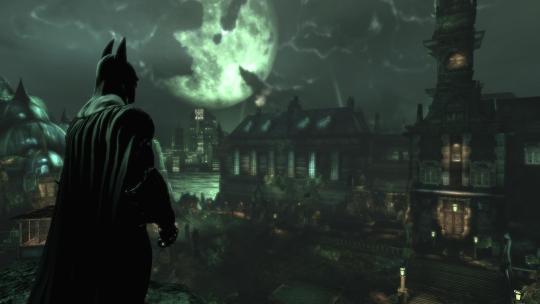
Batman: Arkham Asylum (2009)
Whilst Asylum may not have hit with quite the bombast that its aforementioned predecessors did, the game, like its titular character, hung back in the shadows and hit with precision and deadly efficiency. On first glance, the Arkham series plays like any other third person action-adventure title; Batman moves from the over-the-shoulder viewpoint of Resident Evil 4 and Gears of War; More often than not, the boss battles are marred with the quicktime events God of War introduced us to; Yet get into a fistfight with a group of the many sadists littering the asylum’s beautifully rendered decrepit hallways, and watch the game introduce you to the mechanic that really put the series on the map. It’s a simple system- One button punches, kicks, and generally inflicts copious amounts of pain in the direction of your desired thug, whilst another button counters incoming attacks. The other two buttons in the equation stun and evade, whilst numerous bat shaped gadgets can be incorporated into combat via offshoots of various buttons with the inclusion of a trigger or two. With this in place, combat becomes a glorious ballet of pain, watching Batman glide effervescently between targets whilst delivering fists to the face and snapping limbs with abandon. It’s brilliantly reminiscent of a rhythm-action game; More often that not combat ends up feeling like PaRappa The Rapper meets Streets of Rage, each hit and counter having to be perfectly timed to rack up combos and generally inflict more pain upon your adversaries.
So the combat system, which seemingly every superhero/action game since has tried to replicate, was in place. That’s all well and good, but what’s a good mechanic without a world to be invested in? 10 years on, Arkham Asylum still remains one of gaming’s best haunted houses. It’s twisted corridors, decaying architecture and grim history literally peel off the walls of this madhouse at every turn. It joins the likes of BioShock’s Rapture, Dead Space’s USG Ishimura, Resident Evil’s Spencer Mansion and Alien Isolation’s Sevastopol Station as one of the most atmospheric and claustrophobic settings in recent memory; The asylum is a character within itself, and somehow manages to appear even more twisted and gruesome than the lunatics that occupy it. It’s a Metroidvania-style adventure for the ages, with the inclusion of each new gadget and upgrade that the game feeds you the map, whilst still relatively small by todays standards, manages to feel a little larger somehow by opening up more and more explorable passages, air-vents to crawl through or ledges to traverse, giving you just enough reason to go back to previously explored areas and see what you can uncover the second time around. The narrative is as tight and focused as you could wish for in a Batman game; It’s as linear as they come, yes, but the overwhelming sense of urgency placed upon you in this game is never truly replicated again in the series. The Asylum is so well designed that it never fully stops encroaching on you and providing an underlying sense of uneasiness throughout; Batman knows this place, and he knows the inhabitants, but he doesn’t belong here. This really is their house, and you’re just visiting. Whilst the script and the voice acting can get a little clunky in places; multiple lines and their delivery have become incredibly dated in the time that has passed, it’s a small nitpick as the overall atmosphere this game so seemingly effortlessly conjures up is timeless.
The rapturous reception that greeted Asylum on launch by critics and sales figures alike brought with it a sequel, 2011′s Arkham City. Whilst the core gameplay didn’t change, bar the addition of a few new gadgets and enemy types, the game felt like a swerve in direction from Asylum’s encroaching walls by taking the series into its first sandbox setting. The titular city is a walled-in section of Gotham devised purely to house the gangs of criminals causing chaos on the streets of Gotham; It’s a twisted social experiment courtesy of the enigmatic Dr Hugo Strange, a maze of derelict buildings, burnt out cars and a twisting and elaborate underground system, all fenced in by huge concrete walls and guard towers; it’s inherently military in it’s approach, and more guantanamo in it’s aesthetic. If Asylum felt like Escape From Alcatraz in places, City echoes Escape From New York; Albeit with more deranged clowns and billionaire bachelors playing dress-up.
So if City was essentially Asylum on steroids; The doors ripped off and the buildings demolished, sending the bat into full flight, what wasn’t to love?
It seems a mainstay of modern sandbox games to value quantity over quality; Rocksteady crafted a beautiful, dangerous and dark world in City, yet proceeded to put the map to work by littering it with collectibles in the form of Riddler trophies, rather than any sort of meaningful story connotations, outside of a handful of side-quests. Whilst there are some easter-egg references to friends and foes of Batman who didn’t make the cut in the full game, these are again stretched few and far between in favour of flooding the world with a barrage of collectibles that are designed seemingly to prolong your time with the game; Collecting the trinkets doesn’t ever feel fun or worthwhile, and while some puzzles have their moments, the majority boil down to hitting buttons with a throw of a batarang in a certain sequence; More Bop-It than Batman, it would seem.
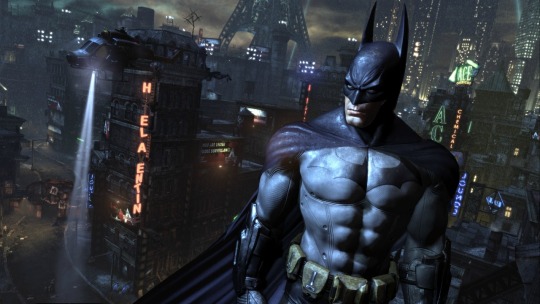
Batman: Arkham City (2011)
It’s a trend among modern open-world games to turn the sandbox you’re given into a hunt for collectibles in stay of any meaningful story content. Ubisoft seem to be the biggest offenders in this case; Assassins’s Creed, Watchdogs and Far Cry have all given us some incredible settings to explore, both from a technical and story standpoint, yet seem intent on cramming them full of fetch-quests or ‘Find x amount of object x’ jaunts which in many cases have led to a multitude of sighs, followed by the ejection of said game from the system. The first Assassins Creed game was a revelation upon release; A journey through the crusades, taking in the holy lands and unraveling a genuinely compelling plot interwoven with conspiracy theories and intrigue, yet come the second game we were thrust into renaissance Italy which, whilst beautiful in it’s design, bogged down the game with unnecessary side-quests, collectibles to hunt down and pages upon pages of in-game encyclopedia entries to trawl your way through. Quantity does not necessarily make a game, and future iterations of the series has seen Ubisoft eager to cram more unnecessary features down our throat in order to try and make the game feel vaguely interesting in lieu of the series’ now overly-bloated bullshit sci-fi story; Upon starting up the most recent entry in the franchise, Unity, I sat through 10 minutes of on-screen pop-ups directing me towards collectibles I hadn’t yet snagged or side-quests the game was so hellbent on getting me to start that I put down the controller, and haven’t returned since.
In the case of the Arkham trilogy, it’s unfortunate that after the backlash from critics that the aforementioned titles received for their over-population of their respective worlds, the most recent and final entry in the series, Arkham Knight, seems to have followed suit.
There’s no doubt that Arkham Knight is still an essential game for fans of Batman, and for fans of action games for that matter, as are all the games in the series. Despite their individual flaws, they’re still gorgeous, solid and engaging titles with great stories, yet Knight seems to be riddled with more problems than it’s counterparts, and even more alarming is the fact that these problems aren’t raised by a man in a green suit placing collectibles around a map for you to hunt down until 4 in the morning. The aforementioned Riddler trophies still remain, and whilst all 200+ of them are still tedium incarnate and all 200+ of them can actually fuck right off, they’re overshadowed by more immediate problems with the game’s design choices.
Despite building up a veritable asylum’s worth of villains over the course of the games in the series, Knight seemingly reduces these characters to bit-parts. Two-Face is part of a side-quest that sees you repeatedly foiling a series of re-skinned bank robberies across Gotham via the same stealth smash-and-grab sequences that have been done a hundred times better before in the series; Penguin returns, superbly voiced by the ever-charismatic Nolan North, as the antagonist of a series of car chases that ultimately result in the same fight repeated more times than necessary, and Firefly is the star of potentially the worst side-quest in the entire saga; Essentially boiling down to arrive at location, wait for Firefly to appear, tail him in some of possibly the worst-controlling driving sections in videogame history thanks to Arkham Knight’s batmobile which controls like a blind labrador on ice, beat the shit out of him when you catch him (Which is I can only imagine out of mostly frustration from said driving sequences), rinse and repeat. It manages not to thrill, yet to tantalise with the dreams of what could have been if the developer had seemingly not played it safe.
When things do get interesting, there’s a slight glimmer of hope, ultimately met with a crashing free-fall back down to reality. One of the game’s most compelling side-quests sees you tracking a serial killer across the city; stumbling across the victims one by one you’ll identify them via an analysis of the body using Batman’s forensic scanner and piece together their history, trying to work out why select people are being targeted and what the pattern to these seemingly random bodies is. It’s an interesting segment, and one that quite rightly showcases the world’s greatest detective living up to the mantle; a refreshing moment of pause that sees brains being favoured over brawn for a moment, however fleeting. Unfortunately, the quest soon manages to overstay its welcome and begins its decent into mediocrity. Upon discovering more and more crucified bodies around the city, each lit up with a spotlight on the deceased and ostensibly calling out to you with bleak operatic music dappling the air, it all comes across invigoratingly unsettling, playing upon your curiosity to see where it all leads. Sadly, where it does end up leading is to a run of the mill ‘boss’ (That term being used very lightly) encounter in which you’re pitted against waves of standard enemies, and then tasked with dispatching said boss via an underwhelming quick-time button press. It crushes any sense of wonder and mystery these side-quests have built up in an instant by reducing a potentially compelling story arc to a sequence we’ve seen done so many times before in the conclusion of so many of the series’ other side-quests; Any essence of individuality in these stories is instantly evaporated by no attempt to give them their own identity, instead they’re hemmed in alongside the main story missions and told to play along and keep inside the box. It all makes for an inherently frustrating experience as the majority of the time with Knight is sadly spent resigning to what could have been, rather than what should be.
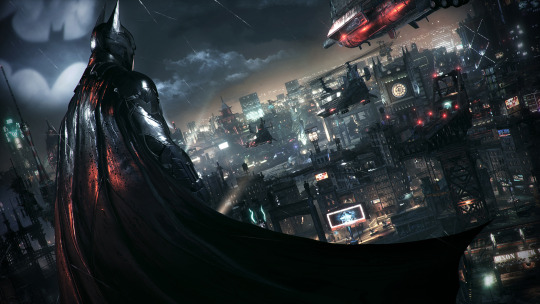
Batman: Arkham Knight (2015)
One of the most glaring blemishes this time around comes in the form of the Batmobile. It’s odd that this is the case; Fans were crying out for the opportunity to drive the nigh-on Bat-tank since its fleeting appearance in Asylum, yet now that it’s arrived it brings with it a whole heap of new problems in its wake. Developer Rocksteady seems to want you to use the Batmobile constantly to traverse Gotham City; Yet why would you when gliding is a more exhilarating, and downright practical option? Part of what makes Batman fucking Batman is his ability to pick off his foes from the shadows, stalking them from the rooftops above, always at his best when he’s playing the silent predator; so why is the game so hell-bent on seeing you screech around city streets, dispatching thugs not with a series of fists to the face, but instead a non-lethal fucking tank round to the face? It removes any sense of risk; Batman always felt almost a little too over-equipped to face his enemies, yet ultimately the outcome of any of these bouts balanced on your prowess with the gadgets, as well as your ability to prioritise and neutralise the most immediate threats, however with the Batmobile in the equation it allows you to drive into an area, clear it with a few taps of the trigger, and move on. It may be quicker and easier, but it’s not Batman, and it’s details like this that have seemingly escaped Rocksteady over the years; For a developer that managed to perfectly encapsulate what made Batman the brilliant character he is in Asylum, they’ve managed to ultimately reduced him to an angry, one-dimensional wrecking ball in Knight.
Characters in Knight don’t seem to echo their comic and graphic novel counterparts so well as they did in Asylum or even City either; It’s more Nolan’s Batman that Moore or Miller’s. Batman is constantly fed upgrades to his suit, Batmobile or gadgets via Lucius Fox, and for all of main antagonist Scarecrow’s brilliant (And I can’t stress how well the game nails these moments of pure terror and tension, because they are fucking edge-of-your-seat horrifying in places, however sparse they are) fear-toxin induced hallucinations and ridiculously tense hostage situations may be, they’re always at an odds with the game’s insistence on pushing the poster-boy of the title, the Arkham Knight himself, into proceedings. Whilst this wouldn’t be a problem if the character was written well, this sadly isn’t the case. The Knight comes across less of a viable threat, and more so an angsty teenager who’s been given access to a group of mercenaries and told to go kill the Batman. The character’s cringe worthy voice-acting, partnered with some truly awful dialogue, completely takes the edge off of proceedings and comes across incredibly soporific.
Whilst the character does build up to an eventually heated reveal, it never really feels that it has managed hit with the impact that it should, or that even Rocksteady thought we might be floored by. The game is paced in such a way that it kept me guessing throughout and teased just enough at just the right times to play with your theories as to who may be behind the mask of the Arkham Knight, and ultimately Jason Todd’s inclusion in the story does manage to land a decent punch, especially to those who have read ‘A Death In The Family’, (the dream-like sequences depicting his torture at the hands of the Joker can be hard to stomach) yet it reduces a character so tortured and so broken down, a friend and ally of Batman’s destroyed at the hands of his greatest enemy, to a blink-and-you’ll-miss-it sequence. The Knight is dispatched with a boss fight that’s we see approximately a hundred times in this game alone, a cutscene plays, and he’s gone. For all the fervour and threat the game wants you to believe that this character poses, it ultimately falls flat due to bad writing and a lack of a satisfying conclusion to their particular story arc. Not only that, but it’s a Spiderman 3 scenario in the sense that the plot is at odds with itself as to who the real main antagonist is; Scarecrow is clearly the more engaging and sinister villain this time around and the one that I wanted to have the most screentime, and whilst I understand that Arkham Knight is meant to be portrayed as posing the most viable threat to Batman and his whole operation, I found myself wanting to blitz through his story sections as quickly as possible to get back to finding what Scarecrow was going to do next. For an original character created for this game alone, Knight is presented as your generic run of the mill evil mercenary leader that we’ve seen in a million films and videogames before. Whilst Jason Todd’s reveal still manages to be somewhat of a sucker punch, one of the few moments in the game I was genuinely engaged by, it never lingers long or weighs as much as a twist in a game like BioShock or Metal Gear Solid; As with most things in this game, it’s been done better before.
So what does Arkham Knight say about the state of the modern videogame sequel? Well, for all the hype and spectacle surrounding the game, it manages to scream disappointment, and the huge push the developers have given to the DLC immediately screams cash-grab; upon downloading the first piece of downloadable story-content available (Also the main piece of content being fronted to sell the season pass for £35), you can’t help but feel robbed. An hour long mission that adds nothing new gameplay-wise, which has barely any story at all; It boils down to go to point A, rescue hostages, go to point B, punch henchmen, rinse and repeat. Staged as a pre-Arkham Asylum prequel where you’re placed in control of Batgirl and Robin, it’s nice enough that they have some screentime and a little more backstory, but was it really needed? Even for the most ardent fan it’s hard to justify the price for its incredibly short length. Ultimately it feels incredibly uninspired and devoid of any new and exciting content that DLC should provide; A reason to jump back into the game world and become re-invested all over again is entirely absent, its soulless and sadly, a product of the times.
The Arkham series as a whole has always felt like its been more than happy to take the safe route when it came to any form of DLC; the bulk of the content pushed out across the series, from City, to Knight, to prequel Origins, has been in the form of costume packs, extra combat or stealth challenge rooms, and most recently in Arkham Knight, batmobile skins. It’s all well and good that Rocksteady clearly has an extensive knowledge of its source material and a clear love for Batman and the expanded universe, but surely this would be put to better use crafting another narrative thread or introducing a character that may not have fit into the main game’s story? Instead we’ve been offered the chance to pay £30 a time for a season pass that is 90% aesthetic-focused, and sadly contains the bare minimum when it comes to story-driven content.
Before Arkham Knight launched, we were presented with the opportunity to purchase the season pass, for £35. For a series that once was a shining beacon for story-driven, immersive and unique experiences in videogames, you can’t help but feel that Rocksteady have fallen by the wayside and lost sight of their original vision for the series. If you take it back to Asylum, we have a singular, tight, hugely immersive and complete story experience, which needed no DLC or add-ons to expand on the main game, because the main game was so damn good in the first place; flash-forward six years and we’re greeted by the final title in the series, which has morphed into something entirely more bloated and convoluted. Arkham Knight is hugely ostentatious, regularly throwing its side-missions, add-ons and ultimately filler content in your face in an attempt to make itself seem like it deserves to be heralded as an all-out, bombastic ending to the series. In the end Arkham, like the majority of the once unique and standout titles in gaming, has become a product of its own success, bled dry of ideas and innovation in pursuit of success, and swallowed by itself.
Still, we can always be optimistic about the inevitable series reboot in 5 years time.
-DU
1 note
·
View note
Text
Death From Above 1979's 'The Physical World' - A Review

Death From Above 1979's explosive debut album made huge waves upon its release in 2004; 10 years on and we've finally received a follow-up to the dance-punk masterpiece. Here we take an in-depth look at their bombastic sophomore effort.
Death From Above 1979 are a Canadian dance-punk duo comprising of Jesse F. Keeler on bass, synths and backing vocals, and Sebastien Grainger on drums and lead vocals, hailing from Toronto. The band released two EP's, a full-length LP and a remix album before splitting in 2006, having since reformed as of 2011 to tour and release a follow-up to their critically acclaimed debut album. DFA 1979's first album, 'You're A Woman, I'm A Machine' was a swirling maelstrom of relentless basslines, pounding drums and glimmering synths laced throughout, all set to the effervescent growl of Sebastien Grainger's vocals. Tracks like Romantic Rights, Blood On Our Hands and Pull Out showcased the duo's talent for lacing danceable riffs over frenetic drums to create the perfect dance-punk album, whilst tracks like Black History Month and Sexy Results slowed the pace somewhat, yet still retained the underlying aggression and fervor of the album. After releasing a remix album which included a few B-sides, the duo called it a day as they both moved on to pursue other projects, with Grainger releasing the indie-rock centric solo LP entitled 'Sebastien Grainger And The Mountains', whilst Keeler joined with the producer of DFA's debut album, AI-P, to form the electronic duo MSTRKRFT, with whom he went on to remix songs from DFA themselves, Justice, and Bloc Party, amongst others, alongside the release of two studio albums.
Thankfully, the fabled second album syndrome suffered by many bands trying to recapture the sound of their debut effort doesn't apply to DFA's glorious sophomore release by any stretch of the imagination. Right from the off, Cheap Talk hits you with a grinding bassline that bounces off of Grainger's legato snare hits, all laced with shimmering hi-hat runs and cow-bell stabs that recall early Rapture and Hot Hot Heat records. It's inherently clear that both Grainger and Keeler have brought elements from their projects away from the band to the table for this album, and the end result is a rich tableau of sounds and ideas that resonate with the listener long beyond the initial playthrough. Grainger is still packing his repertoire of frenetic drumming overlapped with dancefloor kick-drum rhythms and garage-rock vocals that brilliantly growl and wail over the top of Keeler's fuzzy, grime-laced basslines that plug away methodically in the background, though this time around Keeler refines his sound to channel what he learned during his time with MSTRKRFT; his rhythms now recalling those of electro-house basslines, with the added sheen of some oscillating synthesizer melodies on a number of tracks. All in all, the fusion of ideas that the duo manage to create results in a record that refines the messier elements of You're A Woman, I'm A Machine, whilst retaining the trashy feel, though this time it's glossed over somewhat thanks to Grainger's ear for indie-rock vibrancy alongside Keeler's rhythmic and doom-laden yet danceable bass riffs. The track White Is Red is pretty much as close as DFA will ever get to writing a ballad, yet amongst all the furious basslines and unabated drums, it manages to be the standout track on this album. A tale of teen runaways and a failed relationship, it's a cliche that has graced albums and Hollywood screens a million times before, yet Grainger and Keeler manage to make it sound fresh with a down-paced bass riff that's entirely at odds with the rest of the album complementing Grainger's angst-ridden vocals brilliantly. In stark contrast to this, the fantastically fierce and remorseless Gemini packs a concerto of screeching bass, crashing cymbals and punk snarls all set to a riff that harkens back to early Does It Offend You, Yeah? and Late Of The Pier. All things considered, The Physical World is an absolute barnstormer of a comeback album for cult kings Death From Above 1979. It's a back-alley brawler of a record; if said alleys were those of an LA bar drenched in neon and liquor. The attitude and ferocity of their debut album is retained, whilst a vein of dancefloor beats and slick production pulses throughout. It's been long overdue, but it's good to have you back boys.
9/10
0 notes
Text
We Are Scientists - TV en Francais

Indie-rock stalwarts We Are Scientists return to the spotlight with their fourth studio album, TV en Français; but is it worth the four year wait?
Keith Murray (Lead vocals, guitar) and Chris Cain (Bass, backing vocals) are scientists that are used to mixing up their formulas for success. Their first LP, the critically acclaimed With Love And Squalor (2006), was an indie record with a blistering pace. Released into the wild during a period where post-punk was experiencing a spike in popularity due to the efforts of Franz Ferdinand's self-titled debut, The Killers' Hot Fuss and Interpol's Antics, amongst others. Whereas those records ultimately faltered in terms of nailing down truly danceable indie-disco hits, sans the few lead singles, With Love And Squalor nailed that vibe throughout the whole album. A cornucopia of stadium-sized singalong choruses, razor-sharp guitar riffs, drums that hit you like Mike Tyson in a bar fight and basslines that bounced around with gleeful abandon, With Love And Squalor is one of the most complete post-punk/indie records of the last decade.
After the departure of drummer Michael Tapper in November of 2007, the band's musical direction took a turn, as they started looking to bands like The Cure and The Thompson Twins for inspiration on their sophomore effort Brain Thrust Mastery (2008). Trading in the Strokes-esque riffs for 80's pop-rock guitar stabs, and Keith's vocals now swapped from a nervy, Brandon Flowers circa Hot Fuss-era style, to a crooning, soft-rock maestro that sounds at home belting out woaaah's and oooh's over the silky smooth basslines and guitar hooks. That's not to say that they forgot to do big, bombastic rock songs. Tracks like Chick Lit, Dinosaurs and the latter half of Ghouls harken back to the indie-disco barnstormers of With Love And Squalor, whilst the extravagant and undeniably sexy That's What Counts, Lethal Enforcer and Let's See It sound like they wouldn't be out of place in a Hall & Oates songbook; Brain Thrust Mastery is ostentatious in its efforts to make you fall in love with it. The fact that We Are Scientists retained their proficiency for writing singalong riffs, killer choruses and simplistic yet understated lyrics is the reason for their cult following and countless sold out tours.
2010's Barbara saw the band highlighting their exceptional quality for producing breezy, playful riffs, coupled with the new-found love of soft-rock harmonies and fleeting synthesizer wails that debuted on Brain Thrust Mastery. The end result is precise in its execution; it's a bright and energetic record that's perfect for a hot day in July. It oozes charisma and charm right from the off, and although it may dip in the middle due to a lack of memorable riffs, it ultimately pulls off what it sets out to do, and that is to provide you with more evidence that We Are Scientists are incredibly skilled at writing lavish indie-rock with enough charm to ditch the pretense of the genre, all the while retaining those stadium-sized hooks.
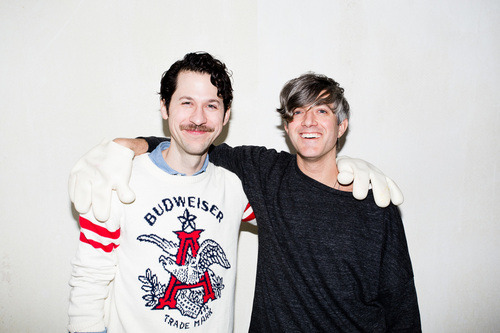
So in comes this years release, TV en Français. Essentially, it's a masterclass in how to write the perfect college-rock album. Taking all the best bits of the bands previous LPs, TV en Français is the sum of its parts; it encompasses the jagged guitar sounds of With Love And Squalor, the soft-rock melodies of Brain Thrust Mastery and the bouncy riffs and basslines of Barbara, and showcases a band that has found their winning formula. It recalls early R.E.M, The Cure and Ash, and each track is a delight. Dumb Luck is exactly that; a big, dumb rock song with a main guitar riff that wouldn't sound out of place in an 80's power-rock epic, Sprinkles is an undeniably sexy track with a thumping bassline and a vocal hook that's all a bit Beach Boys, and Make It Easy is essentially this album's After Hours or Nobody Move; a track that perfectly encapsulates the sound of the album, and We Are Scientists make it sound just that, easy.
All in all, TV en Français is another victory for the scientists; it's a smorgasbord of tracks that show how you do college-rock right in the 21st century. We Are Scientists are a band on top of their game, that have proven time and time again that they're the go-to guys for infectious indie records that get better with each listen. While to some, they may not have breached the barrier that they ultimately set so high for themselves with the sublime With Love And Squalor, that would be missing the point. They're a band that has grown with every record; each showcasing their talents as musicians and songwriters, it's the evolution from nerdy, post-punk newcomers to proficient and proven indie stalwarts that's part of We Are Scientists' charm. Pick up a copy of the album and catch a live show; your ears will thank you.
-DU
0 notes